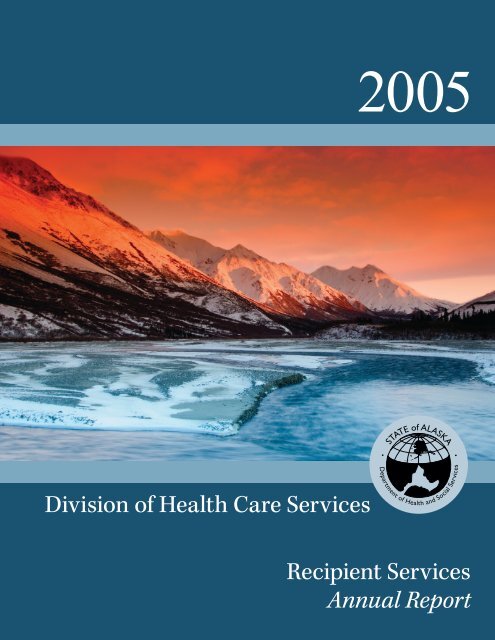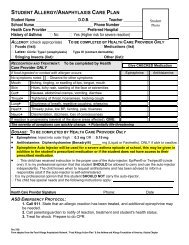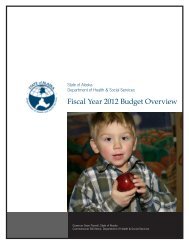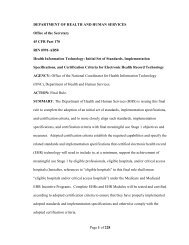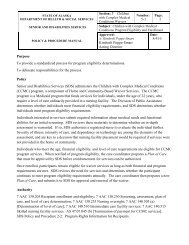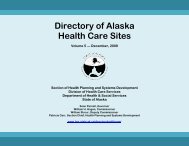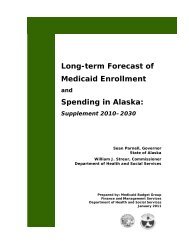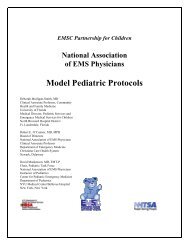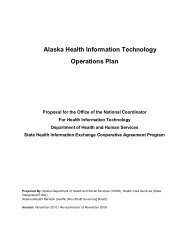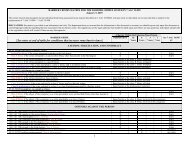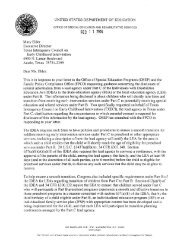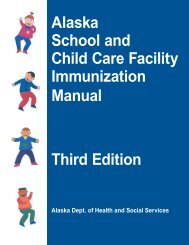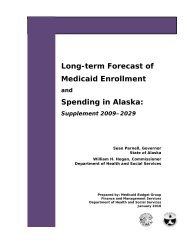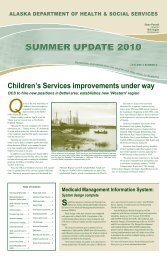Recipient Service AR 2005 V2 - Alaska Department of Health and ...
Recipient Service AR 2005 V2 - Alaska Department of Health and ...
Recipient Service AR 2005 V2 - Alaska Department of Health and ...
Create successful ePaper yourself
Turn your PDF publications into a flip-book with our unique Google optimized e-Paper software.
Division <strong>of</strong> <strong>Health</strong> Care <strong>Service</strong>s<br />
<strong>2005</strong><br />
<strong>Recipient</strong> <strong>Service</strong>s<br />
Annual Report
Executive Summary . . . . . . . . . . . . . . . . . . . . . . . . ii<br />
Vision, Mission, We value . . . . . . . . . . . . . . . . . . . . . 1<br />
Implementation <strong>of</strong> State Travel Office . . . . . . . . . . . . . . . 2<br />
Contractor Meetings with First <strong>Health</strong> <strong>Service</strong>s & the State<br />
Travel Office . . . . . . . . . . . . . . . . . . . . . . . . . . . 5<br />
Fair Hearings . . . . . . . . . . . . . . . . . . . . . . . . . . . 6<br />
Lock In Program . . . . . . . . . . . . . . . . . . . . . . . . . 7<br />
Care Management Program . . . . . . . . . . . . . . . . . . . . 8<br />
Summary . . . . . . . . . . . . . . . . . . . . . . . . . . . 9<br />
<strong>Recipient</strong> Helpline . . . . . . . . . . . . . . . . . . . . . . . . . 9<br />
<strong>Recipient</strong> Reimbursement . . . . . . . . . . . . . . . . . . . . .10<br />
EPSDT . . . . . . . . . . . . . . . . . . . . . . . . . . . . . .12<br />
Mileage reimbursement for use <strong>of</strong> personal automobile . . . . .12<br />
Encourage use <strong>of</strong> Anchorage People Mover Bus Passes . . . . .12<br />
Enhanced Outreach Efforts . . . . . . . . . . . . . . . . . .14<br />
Brief Description <strong>of</strong> EPSDT Program Using FFY 2004 Data . . .15<br />
Miscellaneous Activity . . . . . . . . . . . . . . . . . . . . . .17<br />
Strengths, Weaknesses, Opportunities, Threats . . . . . . . . . .18<br />
This report is intended for <strong>Health</strong> Care <strong>Service</strong>s staff.<br />
Table <strong>of</strong> Contents<br />
©<strong>Alaska</strong> Division <strong>of</strong> Tourism<br />
©<strong>Alaska</strong> Division <strong>of</strong> Tourism<br />
<strong>Recipient</strong> <strong>Service</strong>s Annual Report <strong>2005</strong> i
Executive Summary<br />
<strong>Recipient</strong> <strong>Service</strong>s is immensely proud <strong>of</strong> this, our first annual report. Over the past year, we have<br />
supported our co-workers in the development <strong>of</strong> new programs <strong>and</strong> processes, made enhancements to<br />
existing programs <strong>and</strong> experienced a few setbacks. This report highlights these activities <strong>and</strong> identifies<br />
our goals <strong>and</strong> objectives for the coming year.<br />
One <strong>of</strong> our biggest challenges was the implementation <strong>of</strong> the State Travel Office (STO). We invested<br />
significant resources in making this program not only viable, but a considerable success. The State Travel<br />
Office is able to make booking arrangements, sometimes within minutes, so that recipients <strong>and</strong> loved<br />
ones continue to access health care. With assistance, the STO has increased their knowledge <strong>and</strong> skills in<br />
medical claiming.<br />
The Lock-in program (the Medicaid program that assists recipients in the management <strong>of</strong> their medical<br />
care) experienced a legal challenge that required current participants be dis-enrolled while managers<br />
retooled the program. We used the hiatus to adopt new regulations that added a medical records review<br />
prior to placement <strong>and</strong> we changed the name. The new name, the Care Management program, is a better<br />
description <strong>of</strong> the continuity <strong>of</strong> care afforded by the program. Once legal reviews are completed, we expect<br />
to begin enrolling participants sometime in March or April 2006.<br />
Requests for fair hearings significantly increased this year from 272 in 2004 to 448 in <strong>2005</strong>. The increase<br />
is due to changes in the Choice waiver level <strong>of</strong> care <strong>and</strong> we expect fair hearing requests to remain steady<br />
with pending changes to the personal care attendant program. We are seeking legal advice on notices sent<br />
to recipients requesting reimbursement for services paid out <strong>of</strong> pocket.<br />
The Early <strong>and</strong> Periodic Screening, Diagnosis <strong>and</strong> Treatment program implemented quarterly meetings<br />
with immunization <strong>and</strong> public health to discuss children’s health care issues that require mutual<br />
coordination. The program has also analyzed the use <strong>of</strong> ground transportation <strong>and</strong> is achieving cost<br />
efficiencies by switching agreeable families from taxi to bus travel.<br />
The <strong>Recipient</strong> Helpline continues to be a valuable asset to recipients <strong>and</strong> Division <strong>of</strong> <strong>Health</strong> Care <strong>Service</strong>s<br />
staff alike. The Helpline identifies pressing issues across various programs <strong>and</strong> it allows us to solve issues<br />
before they escalate. This past year the State Travel Office <strong>and</strong> Medicare Part D have been two <strong>of</strong> the most<br />
urgent issues that the Helpline has managed.<br />
We <strong>of</strong>fer this report as an illustration <strong>of</strong> the achievements <strong>and</strong> challenges experienced by the <strong>Recipient</strong><br />
<strong>Service</strong>s unit, <strong>and</strong> we conclude with the results <strong>of</strong> our Strengths, Weaknesses, Opportunities <strong>and</strong> Threats<br />
analysis, goals <strong>and</strong> objectives.<br />
Sincerely,<br />
Jeri Powers, Manager Gerry Johnson, Medical<br />
Assistance Administrator II<br />
ii <strong>Recipient</strong> <strong>Service</strong>s Annual Report <strong>2005</strong><br />
S<strong>and</strong>y Ahlin, Medical<br />
Assistance Administrator III<br />
Mike Huelsman, <strong>Health</strong> <strong>and</strong><br />
Social <strong>Service</strong>s Planner II<br />
Laurie Barter, Medical<br />
Assistance Administrator II
Vision<br />
Vision, Mission, Values<br />
Make a positive difference in the lives <strong>of</strong> <strong>Alaska</strong>ns through knowledge <strong>and</strong> commitment<br />
to excellence in health care administration.<br />
Mission<br />
We will make a difference by:<br />
Enjoying the privilege <strong>of</strong> reaching out to meet the needs <strong>of</strong> others;<br />
Wisely caring for <strong>and</strong> sharing human, ecological <strong>and</strong> financial resources held in trust;<br />
Provide <strong>and</strong> promote access to health care;<br />
Increase awareness <strong>of</strong> our programs through outreach services.<br />
We value<br />
Equity <strong>and</strong> fairness in all relationships.<br />
The Gumlikpuk family <strong>of</strong> Kwethluk.<br />
<strong>Recipient</strong> <strong>Recipient</strong> <strong>Service</strong>s <strong>Service</strong>s Annual Annual Report Report <strong>2005</strong> <strong>2005</strong> 1
Implementation <strong>of</strong> State Travel Office<br />
The <strong>Department</strong> contracted with USTravel (dba State Travel Office) to begin providing travel services for<br />
Medicaid recipients effective January 1, <strong>2005</strong>. A short implementation timeline caused a flurry <strong>of</strong> ramp-up<br />
activity in December, 2004, with daily meetings, systems interface sessions for the two contractors <strong>and</strong><br />
required notices for providers, air carriers, recipients <strong>and</strong> individual travel agencies.<br />
First <strong>Health</strong> <strong>Service</strong>s began faxing Prior Authorizations to USTravel the last week in December, 2004,<br />
for travel that crossed over into the new year. During that introductory week, activity was brisk yet<br />
manageable with USTravel receiving 557 prior authorizations <strong>and</strong> processing 235 travelers. On January<br />
3, <strong>2005</strong>, the State Travel Office’s phone system failed to h<strong>and</strong>le the volume <strong>of</strong> total activity. An interim<br />
plan was developed until USTravel could add more phone lines to their system. Agents were stationed at<br />
First <strong>Health</strong> with urgent travel calls forwarded <strong>and</strong> then triaged to available agents throughout the state.<br />
Within a remarkably short period <strong>of</strong> time, USTravel added additional telecommunications trunk lines,<br />
increased the number <strong>of</strong> agents <strong>and</strong> centralized operations into their Anchorage headquarters.<br />
As we implemented the State Travel Office, our concern was that no single travel agency could manage<br />
the dem<strong>and</strong>s <strong>of</strong> hundreds <strong>of</strong> daily travelers. Medicaid recipients are used to a responsive system allowing<br />
them to travel literally within minutes if needed. None <strong>of</strong> our fears were realized. Well-child screens 1<br />
have remained steady or have increased slightly, <strong>and</strong> we have received only 55 complaints (0.23% <strong>of</strong> all<br />
Helpline calls) about the new system.<br />
Through weekly meetings <strong>and</strong> ongoing efforts, we have refined, updated <strong>and</strong> strengthened our travel<br />
systems. Highlights include:<br />
1-31-05 Changed unit configuration to one<br />
unit equals one-way, regardless <strong>of</strong> the<br />
number <strong>of</strong> legs in the one-way segment<br />
2 <strong>Recipient</strong> <strong>Service</strong>s Annual Report <strong>2005</strong><br />
Activity Outcome<br />
Improved tracking <strong>of</strong> trips<br />
3-7-05 Activated service code A0170 Better tracking <strong>of</strong> service fees<br />
4-19-05 Implemented cell phone contact<br />
exclusively for urgent travel<br />
June 05 Implemented ongoing claiming <strong>and</strong><br />
adjustment oversight<br />
Individuals on the organ transplant list have<br />
direct contact with an agent<br />
Incremental improvements in claims accuracy<br />
7-29-05 Introduced 9-day lag into billing cycle Increased time to research <strong>and</strong> submit clean<br />
claims. Denial rate decreased from 5.0% to 2.6%<br />
8-22-05 Submitted Freedom <strong>of</strong> Choice Waiver to<br />
CMS<br />
Better use <strong>of</strong> cost-effective air carriers once the<br />
waiver becomes effective<br />
11-5-05 Added weekend PA staff Improved customer service<br />
12-5-05 Added new procedure for managing a<br />
“used” PA<br />
Reduce denied claims<br />
In process Provider contracts Stabilize air fares<br />
1 Most children living in rural areas travel for a well-child screen.
Implementation <strong>of</strong> State Travel Office<br />
The following graph summarizes USTravel billing activity over the past year. While sales are relatively<br />
consistent at $450,000 per week, accounts receivable are remarkable for their variability. January through<br />
March reflects USTravel’s learning curve on medical claiming <strong>and</strong> use <strong>of</strong> an inefficient manual data-entry<br />
billing system. The sharp decline in receivables the latter part <strong>of</strong> March represents full implementation <strong>of</strong><br />
an electronic billing process.<br />
$3,000,000<br />
$2,500,000<br />
$2,000,000<br />
$1,500,000<br />
$1,000,000<br />
$500,000<br />
$-<br />
Jan<br />
USTravel Medicaid Activity, <strong>2005</strong><br />
Feb<br />
Mar<br />
Apr<br />
May<br />
Jun<br />
Jul<br />
Seeing a gradual increase in receivables April through June, <strong>Health</strong> Care <strong>Service</strong>s <strong>and</strong> <strong>Department</strong> <strong>of</strong><br />
Administration met with USTravel in July to discuss claiming practices. USTravel responded to our<br />
concerns by implementing a variety <strong>of</strong> quality assurance practices to include better management <strong>of</strong><br />
incoming prior authorizations, increased staffing in the accounting <strong>of</strong>fice <strong>and</strong> improved billing practices.<br />
The “v-notch” in September sales represents the nine day delay before submission <strong>of</strong> claims with an<br />
associated decline in receivables some two weeks later.<br />
<strong>Health</strong> Care <strong>Service</strong>s contributed by providing support staff to assist in all aspects <strong>of</strong> claims processing.<br />
Laurie Barter met daily <strong>and</strong> then weekly with accounting staff to assist with claims <strong>and</strong> adjustments.<br />
Due in part to Ms. Barter’s efforts, Medicaid has recovered $98,320 in adjustments <strong>and</strong> $214,000 in voided<br />
claims.<br />
The State Travel Office is in the process <strong>of</strong> developing a Remittance Advise database. This database will<br />
be an extremely useful tool for the State Travel Office accounting staff to view <strong>and</strong> research all details <strong>of</strong> a<br />
claim.<br />
<strong>Recipient</strong> <strong>Service</strong>s participates in weekly accounting meetings with the <strong>Department</strong> <strong>of</strong> Administration<br />
<strong>and</strong> USTravel. This has been beneficial in keeping all parties updated about the utilization <strong>of</strong> the asset<br />
account <strong>and</strong> an opportunity to brainstorm on ways to improve travel <strong>and</strong> billing processes.<br />
Aug<br />
Sept<br />
Oct<br />
Nov<br />
Dec<br />
Sales<br />
USTravel A/R<br />
<strong>Recipient</strong> <strong>Recipient</strong> <strong>Service</strong>s <strong>Service</strong>s Annual Annual Report Report <strong>2005</strong> <strong>2005</strong> 3
Implementation <strong>of</strong> State Travel Office<br />
Performance measures were implemented for the State Travel Office in the last quarter <strong>of</strong> <strong>2005</strong> with<br />
results still being compiled. As part <strong>of</strong> the service performance measure <strong>of</strong> their contract, customer<br />
satisfaction surveys were sent out to recipients <strong>and</strong> providers. Of the 450 surveys sent out, over 80 have<br />
been received for a return rate <strong>of</strong> about 18 percent. Using a Likert Scale, the State Travel Office has<br />
received a 93 percent satisfaction rating from recipients, health aides <strong>and</strong> parent/family members.<br />
The following is a synopsis <strong>of</strong> first year State Travel Office operations:<br />
4 <strong>Recipient</strong> <strong>Service</strong>s Annual Report <strong>2005</strong><br />
Total Items Received<br />
or Processed<br />
PA’s Received 75,384<br />
Travelers Processed 77,989<br />
Average Cost per<br />
Transaction<br />
Sales<br />
Air Transactions Issued 79,188 $284.14 $22,500,662<br />
Ferry Transactions Issued 2,039 $51.56 $105,138<br />
Transaction Fees 63,664 $1,353,138<br />
Totals $23,958,938<br />
In summary, the benefits <strong>of</strong> centralized services through the State Travel Office include:<br />
1. Higher level <strong>of</strong> customer service<br />
2. Improved managerial controls<br />
3. Reduction <strong>of</strong> provider <strong>and</strong> recipient misuse <strong>of</strong> the program<br />
4. Air carriers no longer need to submit medical claims for reimbursement
Contractor Meetings (First <strong>Health</strong> <strong>Service</strong>s & the State Travel Office)<br />
Because 95 percent <strong>of</strong> calls received by the prior authorization staff are related to travel, <strong>Recipient</strong><br />
<strong>Service</strong>s meets biweekly with the prior authorization manager to discuss issues as they occur. These<br />
meetings have proven to be a valuable tool to provide additional policy clarification <strong>and</strong> procedures<br />
for the prior authorization staff via flow charts <strong>and</strong> written guidelines. Open communication,<br />
documentation <strong>of</strong> data <strong>and</strong> utilization <strong>of</strong> resources<br />
are essential to the continued success <strong>of</strong> the prior<br />
authorization process, <strong>and</strong> <strong>Recipient</strong> <strong>Service</strong>s is<br />
committed to their success.<br />
In <strong>2005</strong>, the prior authorization staff generated<br />
46,779 2 approved prior authorizations for travel<br />
alone.<br />
In efforts to keep the prior authorization data flow<br />
<strong>and</strong> communication open between First <strong>Health</strong><br />
<strong>Service</strong>s <strong>and</strong> the State Travel Office, <strong>Recipient</strong><br />
<strong>Service</strong>s participates in monthly meetings with<br />
both contractors. This was implemented in December <strong>and</strong>, although not long-st<strong>and</strong>ing, has been<br />
beneficial. The First <strong>Health</strong> prior authorization manager <strong>and</strong> the USTravel Medicaid agent manager are<br />
the contractor participants.<br />
2 Unduplicated<br />
<strong>Recipient</strong> <strong>Recipient</strong> <strong>Service</strong>s <strong>Service</strong>s Annual Annual Report Report <strong>2005</strong> <strong>2005</strong> 5
Fair Hearings<br />
During the <strong>2005</strong> calendar year, 448 hearings were requested. We have received 33 decisions with<br />
the Agency upheld in 24. The Agency was reversed in six hearings with three mixed decisions. The<br />
breakdown by Agency:<br />
6 <strong>Recipient</strong> <strong>Service</strong>s Annual Report <strong>2005</strong><br />
DSDS LOC DSDS Misc 3 DHCS Qualis<br />
Hearing Scheduled or awaiting a decision 33 10 7 5<br />
Hearing withdrawn 91 30 15 5<br />
Hearing conceded 156 14 19 13<br />
Hearing ab<strong>and</strong>oned 1 1 1 1<br />
Stayed due to court challenge 7<br />
Hearing dismissed 4 2<br />
Agency upheld 19 5 2 0<br />
Agency reversed 1 3 1<br />
Mixed Decision 1 2<br />
Totals 308 64 51 25<br />
Percent <strong>of</strong> total hearings 69% 14% 11% 6%<br />
3 Includes Children with Complex Medical Conditions waiver, Mentally Retarded/Developmentally Ddisabled waiver,<br />
Personal Care Attendent, Respite <strong>and</strong> Covered <strong>Service</strong>s
Lock In Program<br />
• Since 1992 a total <strong>of</strong> 309 recipients have been placed in the Lock In program. Average placement for<br />
each recipient lasted an average <strong>of</strong> 12 months.<br />
• The total number <strong>of</strong> recipients active in the Lock In program during <strong>2005</strong> was 133.<br />
• 117 <strong>of</strong> these recipients were actively participating in the Lock In program during the third quarter <strong>of</strong><br />
<strong>2005</strong> — which was the final quarter for the Lock in program.<br />
• <strong>Alaska</strong> Legal <strong>Service</strong>s represented a recipient during a Fair Hearing regarding placement in the Lock<br />
in program. Decision was in favor <strong>of</strong> the recipient.<br />
• <strong>Alaska</strong> Legal <strong>Service</strong>s proposed a class action lawsuit against the <strong>Department</strong> regarding the agency’s<br />
notice <strong>and</strong> also challenged the regulation that allowed for a presumption that a service had been used<br />
at a level that was not medically necessary.<br />
• All Lock In recipients were withdrawn from the program by October 1, <strong>2005</strong>, whether or not they had<br />
been in the program for 12 months.<br />
• The Lock In program is replaced with the Care Management Program.<br />
<strong>Recipient</strong> <strong>Recipient</strong> <strong>Service</strong>s <strong>Service</strong>s Annual Annual Report Report <strong>2005</strong> <strong>2005</strong> 7
Care Management Program<br />
New regulations were drafted <strong>and</strong> went into effect September 23, <strong>2005</strong>, that replaced the existing Lock In<br />
regulation.<br />
• An additional step <strong>of</strong> medical records review has been added to the selection process. A health care<br />
pr<strong>of</strong>essional reviews medical records <strong>and</strong> determines if the excessive use <strong>of</strong> services by the selected<br />
recipient was medically necessary.<br />
• Notice <strong>of</strong> placement into the Care Management program now includes the results <strong>of</strong> the medical<br />
review.<br />
• The revised notice has been with <strong>Alaska</strong> Legal <strong>Service</strong>s since October 3, <strong>2005</strong>, with additional<br />
requested information provided to them on December 14, <strong>2005</strong>.<br />
• The Care Management Program is “on hold” until <strong>Alaska</strong> Legal <strong>Service</strong>s reviews the notice <strong>and</strong><br />
communicates its intent regarding the class action lawsuit.<br />
• <strong>Recipient</strong>s have been selected <strong>and</strong> medical reviews are completed <strong>and</strong> ready to be sent out when we<br />
receive notice that the lawsuit has been dismissed.<br />
Plan<br />
• Ten to 15 recipients will be placed in the Care Management Program each month.<br />
• Comparative usage <strong>of</strong> medical services will be tracked <strong>and</strong> reported to the Agency by First <strong>Health</strong><br />
to include quarterly <strong>and</strong> yearly use for each recipient. This will include the year prior to placement,<br />
during placement <strong>and</strong> the year after completion <strong>of</strong> 12 months <strong>of</strong> eligibility on the Care Management<br />
Program.<br />
• Reports mentioned above will track the change <strong>of</strong> financial burden on Medicaid as services are<br />
accessed by Care Management Program participants.<br />
• Anticipate fair hearing requests will significantly decrease due to comprehensive new notice.<br />
8 <strong>Recipient</strong> <strong>Service</strong>s Annual Report <strong>2005</strong>
Challenges<br />
Care Management Program<br />
• Providers do not return medical records within the two-week timeframe. Medical necessity reviews<br />
for selected recipients are delayed while waiting for providers to send requested records.<br />
• Completing the process <strong>of</strong> placing a recipient in the Care Management Program has become more<br />
time-intensive due to the wait for medical records <strong>and</strong> the addition <strong>of</strong> a medical review.<br />
• <strong>Recipient</strong> Notices are now approximately 14 pages long due to the inclusion <strong>of</strong> the medical review, thus<br />
increasing mailing costs.<br />
Summary<br />
The Care Management Program Staff with First <strong>Health</strong> have been pr<strong>of</strong>essional <strong>and</strong> innovative during this<br />
transition from the Lock In program to the Care Management Program. It is the norm for them to go<br />
above <strong>and</strong> beyond what is requested <strong>of</strong> them by <strong>Health</strong> Care <strong>Service</strong>s. They act as case managers for the<br />
recipient as well as the provider, <strong>and</strong> perform the duties <strong>of</strong> a liaison between the two with commendable<br />
patience <strong>and</strong> pr<strong>of</strong>essionalism. Bimonthly meetings between <strong>Health</strong> Care <strong>Service</strong>s <strong>and</strong> First <strong>Health</strong><br />
Staff have proven to be very helpful <strong>and</strong> assists in setting realistic goals for this program, which are<br />
consistently met <strong>and</strong> <strong>of</strong>ten times exceeded.<br />
<strong>Recipient</strong> <strong>Recipient</strong> <strong>Service</strong>s <strong>Service</strong>s Annual Annual Report Report <strong>2005</strong> <strong>2005</strong> 9
<strong>Recipient</strong> Helpline<br />
The Helpline remains a valuable resource for Medicaid recipients with very few customers expressing<br />
dissatisfaction. During <strong>2005</strong>, the Helpline experienced a reduction in staff from five to two resulting in<br />
increased wait time. On average the Helpline receives about 2,600 calls per month.<br />
The tracking <strong>of</strong> “Hot Topics” in the Remedy database has been in effect since establishing the Helpline.<br />
These topics have included calls concerning the implementation <strong>of</strong> the State Travel Office as well as the<br />
newly implemented Medicare Part D. This tracking provides a guide as to how well the information that is<br />
provided to the recipient is received <strong>and</strong> understood.<br />
Plan<br />
Total Monthly Calls<br />
3500<br />
3000<br />
2500<br />
2000<br />
1500<br />
1000<br />
500<br />
0<br />
• Implement Quality Assurance process<br />
• Monthly meeting with Helpline staff to review questions <strong>and</strong> concerns<br />
The Helpline Business Cards have been in great dem<strong>and</strong> this year. The Division <strong>of</strong> Public Assistance <strong>of</strong>fices<br />
have especially found them to be a good asset to provide to recipients at the time <strong>of</strong> application or review.<br />
10 <strong>Recipient</strong> <strong>Service</strong>s Annual Report <strong>2005</strong><br />
<strong>Recipient</strong> Helpline Performance<br />
Average Wait Time<br />
1:40<br />
Jan Feb Mar Apr May June July Aug Sept Oct Nov<br />
1:26<br />
1:12<br />
0:57<br />
0:43<br />
0:28<br />
0:14<br />
0:00
<strong>Recipient</strong> Reimbursement<br />
There were 97 recipient requests for reimbursement for out-<strong>of</strong>-pocket expenses in <strong>2005</strong>.<br />
• Data for 2004 are incomplete; however we estimate a total <strong>of</strong> 48 reimbursement requests.<br />
Reimbursement requests for <strong>2005</strong> have doubled<br />
Plan<br />
• Review reimbursement request process<br />
• Establish parameters for accepting requests for reimbursement when no denial exists<br />
• Review amount that recipient is reimbursed — out-<strong>of</strong>-pocket vs. Medicaid allowed amount<br />
• Reduce number <strong>of</strong> fair hearing requests for direct reimbursement to recipient<br />
<strong>Recipient</strong> <strong>Recipient</strong> <strong>Service</strong>s <strong>Service</strong>s Annual Annual Report Report <strong>2005</strong> <strong>2005</strong> 11
EPSDT (Early <strong>and</strong> Periodic Screening, Diagnosis <strong>and</strong> Treatment Program)<br />
Mileage reimbursement for use <strong>of</strong> personal automobile<br />
Prior to May 2004, ground transportation was paid at 10 cents per mile. It was decided this rate was<br />
too low <strong>and</strong> was changed to 37 cents per mile, the rate paid for state employees. This in turn was<br />
automatically raised to 40.5 cents per mile January <strong>2005</strong>.<br />
Starting in March <strong>2005</strong> we began a study <strong>of</strong> Early <strong>and</strong> Periodic Screening, Diagnosis <strong>and</strong> Treatment travel<br />
expenditures. As shown in the chart below, mileage reimbursement expenditures per six-month period<br />
rose sharply after changing to the state employee rate <strong>and</strong> peaked in the first half <strong>of</strong> <strong>2005</strong> at over $15,000.<br />
Between July 2002 <strong>and</strong> June 2004 the cost <strong>of</strong> travel ranged from about $1,500 to $3,000 per half-year<br />
period.<br />
Starting July <strong>2005</strong> we based the mileage rate on the IRS St<strong>and</strong>ard Mileage Rate for vehicle travel for<br />
medical purposes. The lower rate, which was regularly adjusted due to increases in gasoline costs, ranged<br />
between 15 cents <strong>and</strong> 22 cents a mile between July <strong>and</strong> December <strong>2005</strong>. Starting January 1, 2006, it is 18<br />
cents per mile. After implementation to the lower rate, the number <strong>of</strong> trips billed dropped from 174 for<br />
January through June <strong>2005</strong> to about 75 for July through December <strong>2005</strong>. In addition, as shown in the chart<br />
below, the costs also dropped to less than $4,000 for the last six months <strong>of</strong> <strong>2005</strong>. During the first half<br />
<strong>of</strong> <strong>2005</strong> staff spent a considerable amount <strong>of</strong> time assuring that travel was medically necessary <strong>and</strong> not<br />
overbilled. Since the change these problems have almost ceased.<br />
Cost <strong>of</strong> Mileage Reimbursement in Six Month Intervals, July 2002 to December <strong>2005</strong><br />
$18,000<br />
$16,000<br />
$14,000<br />
$12,000<br />
$10,000<br />
$8,000<br />
$6,000<br />
$4,000<br />
$2,000<br />
Rate 10¢ per mile<br />
$0 Jul-Dec 2002 Jan-Jun 2003 July-Dec 2003 Jan-Jun 2004 Jul-Dec 2004 Jan-Jun <strong>2005</strong> Jul-Dec <strong>2005</strong> Est.<br />
12 <strong>Recipient</strong> <strong>Service</strong>s Annual Report <strong>2005</strong><br />
10¢<br />
Study begins<br />
March <strong>2005</strong><br />
Change<br />
implemented<br />
July <strong>2005</strong><br />
Biannual Cost<br />
37.5¢<br />
40.5¢<br />
15-22¢
EPSDT (Early <strong>and</strong> Periodic Screening, Diagnosis <strong>and</strong> Treatment Program)<br />
Encourage use <strong>of</strong> Anchorage People Mover Bus Passes<br />
The Early <strong>and</strong> Periodic Screening, Diagnosis <strong>and</strong> Treatment travel program has begun experimenting<br />
with using the Anchorage bus system. In the fall <strong>of</strong> <strong>2005</strong>, it formed a partnership with a social worker<br />
at <strong>Alaska</strong> Native Tribal <strong>Health</strong> Consortium to provide bus passes to parents. This service assisted the<br />
health consortium in reducing the length <strong>of</strong> hospital stays. We used the opportunity to experiment using<br />
bus transportation instead <strong>of</strong> taxis. Besides using the pass for medical purposes, the parents can use<br />
it for other useful purposes. A monthly adult bus pass is usually $50. However, the Early <strong>and</strong> Periodic<br />
Screening, Diagnosis <strong>and</strong> Treatment travel program is eligible for a 50 percent discount or $25 per month<br />
for an adult. Half- month passes can be purchased around the 15th <strong>of</strong> the month for $12.50. Youth passes<br />
are half the cost <strong>of</strong> adult passes.<br />
All <strong>of</strong> the parents with hospitalized children accepted the <strong>of</strong>fer. We also <strong>of</strong>fered the pass to a single parent<br />
who travels by taxi weekly with her child for speech therapy. She was our first refusal saying “it wouldn’t<br />
work.” We found this to be reasonable as she has four children under the age <strong>of</strong> four years, including<br />
a baby, making bus travel difficult, especially in the winter. We compared the costs <strong>of</strong> bus travel to<br />
estimated taxi travel for participating parents <strong>and</strong> this is summarized in the table below:<br />
<strong>Recipient</strong> Issue Purpose Desired Impact Bus Pass Cost Est. Cab Costs<br />
1 Premature<br />
twins<br />
2 Fragile<br />
child<br />
3 Premature<br />
child<br />
4 Fragile<br />
child<br />
Teach mother to<br />
care for children <strong>and</strong><br />
enable continuation <strong>of</strong><br />
breastfeeding. The babies<br />
stayed in the hospital after<br />
mother was discharged.<br />
Teach mother <strong>of</strong><br />
hospitalized child how<br />
to maintain medical<br />
equipment at home<br />
Teach mother to care<br />
for fragile child <strong>and</strong><br />
enable continuation <strong>of</strong><br />
breastfeeding. The baby<br />
stayed in the hospital after<br />
mother was discharged.<br />
Teach both parents how to<br />
care for hospitalized child<br />
at home <strong>and</strong> to operate<br />
medical equipment.<br />
Earlier discharge<br />
from hospital,<br />
reduce future<br />
medical costs<br />
through<br />
breastfeeding.<br />
Earlier discharge<br />
from hospital.<br />
Earlier discharge<br />
from hospital,<br />
reduce future<br />
medical costs<br />
through<br />
breastfeeding.<br />
Earlier discharge<br />
from hospital<br />
$25 for two<br />
weeks<br />
$25 for two<br />
weeks<br />
$350 for 10<br />
days cab fare<br />
$125 for 5 days<br />
cab fare<br />
$37 for 6 weeks $1,125 for 42<br />
days cab fare<br />
$50 for 1<br />
month for 2<br />
parents<br />
$750 for 30<br />
days cab fare<br />
Total $137 $2,350<br />
<strong>Recipient</strong> <strong>Recipient</strong> <strong>Service</strong>s <strong>Service</strong>s Annual Annual Report Report <strong>2005</strong> <strong>2005</strong> 13
EPSDT (Early <strong>and</strong> Periodic Screening, Diagnosis <strong>and</strong> Treatment Program)<br />
Our next step will be to experiment with an <strong>of</strong>fer to all Anchorage area parents needing Early <strong>and</strong><br />
Periodic Screening, Diagnosis <strong>and</strong> Treatment travel assistance giving them the option <strong>of</strong>:<br />
• A bus pass for the balance <strong>of</strong> the month, or<br />
• Taxi authorization<br />
Those not choosing the bus pass will be asked the reason. Documentation will be kept <strong>of</strong> the option<br />
selected <strong>and</strong> the reason for not choosing a bus pass.<br />
Enhanced Outreach Efforts<br />
<strong>Recipient</strong> <strong>Service</strong>s presently sends federally required informing letters to parents whose children are not<br />
current on their well-child visits, have not used services for a year, or who are new to the program. The<br />
letter is unattractive <strong>and</strong> bureaucratic. Also included is a newsletter with broadly targeted information<br />
for a wide range <strong>of</strong> ages <strong>and</strong> developmental stages.<br />
In a Lower 48 study, parents <strong>of</strong> Medicaid families participated in focus groups about informing letters.<br />
They were asked what the letters should look like <strong>and</strong> said:<br />
• Please only send notices once a year.<br />
• Recognize we care about our kids <strong>and</strong> can make the right decisions, if you give us the information.<br />
• We would appreciate a reminder, if it is age appropriate <strong>and</strong> concise.<br />
• Help us underst<strong>and</strong> what to talk to the doctor about.<br />
• Give us a bright postcard we can put on the fridge.<br />
Using this information we are developing a new approach <strong>and</strong> design by:<br />
• Drafting 20 separate concise letters containing age specific recommendations based on Bright Futures<br />
guidelines;<br />
• Personalizing the text with the child’s name <strong>and</strong> local contact information;<br />
• Print it on brightly colored card-like designed stationary;<br />
• Incorporate birthday images into the design to serve as a reminder to schedule preventative<br />
appointments at least annually;<br />
• Mail it soon after the child’s birth <strong>and</strong> just before birthdays.<br />
14 <strong>Recipient</strong> <strong>Service</strong>s Annual Report <strong>2005</strong>
EPSDT (Early <strong>and</strong> Periodic Screening, Diagnosis <strong>and</strong> Treatment Program)<br />
We are in the process <strong>of</strong> organizing the transition. Major areas to be addressed include:<br />
• Issuing three printing-related bids; continue the present printing <strong>and</strong> mailing effort during the<br />
transition; printing <strong>of</strong> the card stock; <strong>and</strong> printing the individualized text <strong>and</strong> mailing the newly<br />
designed notice;<br />
• Finding a way to tease out <strong>of</strong> the current Medicaid Management Information System the needed<br />
information;<br />
• Developing designs for the cards;<br />
• Coordinating with <strong>and</strong> informing a wide range <strong>of</strong> partners including native health corporations,<br />
pediatricians, public health nurses, dentists <strong>and</strong> others in the health community.<br />
Brief Description <strong>of</strong> Early <strong>and</strong> Periodic Screening, Diagnosis <strong>and</strong><br />
Treatment Program Using Federal Fiscal Year 2004 Data<br />
The total number <strong>of</strong> Early <strong>and</strong> Periodic Screening, Diagnosis <strong>and</strong> Treatment enrolled children continues<br />
to increase while the number <strong>of</strong> children enrolled in Denali KidCare slowly decreases.<br />
Number Enrolled<br />
70,000<br />
60,000<br />
50,000<br />
40,000<br />
30,000<br />
20,000<br />
10,000<br />
0<br />
Comparison <strong>of</strong> Number Enrolled in Medicaid Only <strong>and</strong> SCHIP,<br />
Ages 0 up to 19 years, FFY 1999-2004<br />
SCHIP or on Medicaid <strong>and</strong> SCHIP During Year<br />
Medicaid Only<br />
1999 2000 2001 2002 2003 2004<br />
Federal Fiscal Year<br />
The number <strong>of</strong> eligible Early <strong>and</strong> Periodic Screening, Diagnosis <strong>and</strong> Treatment children increased by 1.2<br />
percent in Federal Fiscal Year 2004. This increase is similar to pre Denali KidCare years <strong>and</strong> appears to be<br />
based on population growth.<br />
<strong>Recipient</strong> <strong>Recipient</strong> <strong>Service</strong>s <strong>Service</strong>s Annual Annual Report Report <strong>2005</strong> <strong>2005</strong> 15
EPSDT (Early <strong>and</strong> Periodic Screening, Diagnosis <strong>and</strong> Treatment Program)<br />
In Federal Fiscal Year 2004 the number <strong>of</strong> Early <strong>and</strong> Periodic Screening, Diagnosis <strong>and</strong> Treatment screens<br />
increased by 4.7 percent, a welcome but modest increase. The five-year average is 7.7 percent. The higher<br />
average five- year rate is probably due to the implementation <strong>of</strong> Denali KidCare.<br />
Because our number <strong>of</strong> screens increased more than the increase in number <strong>of</strong> eligible children, our<br />
screening ratio improved slightly from 0.665 in FFY03 to 0.692 in Federal Fiscal Year 2004. Our screening<br />
ratio has improved four years straight with Federal Fiscal Year 2004 being the highest rate in recent<br />
history. This suggests that the Medicaid/ Denali KidCare health system is continuing to increase the rate<br />
<strong>of</strong> preventative health care for children.<br />
Total Early <strong>and</strong> Periodic Screening, Diagnosis <strong>and</strong> Treatment Screens Statewide, 1995-2004<br />
100,000<br />
90,000<br />
80,000<br />
70,00<br />
60,000<br />
50,000<br />
40,000<br />
30,000<br />
20,000<br />
10,000<br />
0<br />
Total Individuals Eligible for EPSDT<br />
Total Screens<br />
16 <strong>Recipient</strong> <strong>Service</strong>s Annual Report <strong>2005</strong><br />
Start <strong>of</strong> DKC<br />
March 1, 1999<br />
DKC Eligibility Ceiling<br />
changed from 200%<br />
to 175% FPL starting<br />
September 1, 2003<br />
1995 1996 1997 1998 1999<br />
Year<br />
2000 2001 2002 2003 2004<br />
Early <strong>and</strong> Periodic Screening, Diagnosis <strong>and</strong> Treatment Screening Ratio All Ages, 1995-2004<br />
Screening Ratio<br />
.800<br />
.700<br />
.600<br />
.500<br />
.400<br />
.300<br />
.200<br />
.100<br />
.000<br />
Changes to Federal 416<br />
Report take effect<br />
Start <strong>of</strong> Denali KidCare<br />
March 1, 1999<br />
1995 1996 1997 1998 1999 2000 2001 2002 2003 2004<br />
Federal Fiscal year October 1 - September 30
• <strong>Health</strong> Care <strong>Service</strong>s was awarded a $35,000 transportation planning <strong>and</strong> coordination grant. No<br />
activity has yet occurred under this grant <strong>and</strong> we are requesting to subcontract the actual study <strong>and</strong><br />
report.<br />
• School Based <strong>Service</strong>s added Behavioral <strong>Health</strong> interventions to the array <strong>of</strong> services. Jeri Powers<br />
provided on-site training to the Yukon-Kuskowim School District on School Based <strong>Service</strong>s <strong>and</strong><br />
presented to the Special Education Directors at their annual conference.<br />
• Jeri Powers <strong>and</strong> Laurie Barter attended the <strong>Department</strong> <strong>of</strong> Transportation annual Coordinated<br />
Transportation Conference.<br />
• Office <strong>of</strong> Program Review submitted the Freedom <strong>of</strong> Choice Waiver late last fall <strong>2005</strong>. We anticipate<br />
implementation on March 1, 2006.<br />
• S<strong>and</strong>y Ahlin is coordinating the updating <strong>of</strong> the <strong>Recipient</strong> H<strong>and</strong>book.<br />
Miscellaneous Activity<br />
• Provided onsite training for accommodation provider Ramada Ltd Hotel <strong>of</strong> Anchorage. Ramada<br />
encountered many claims that were not submitted to Medicaid or submitted improperly without<br />
follow up. Meetings were also set up with First <strong>Health</strong> <strong>and</strong> Ramada in order to review these claims<br />
<strong>and</strong> provide help in the resubmission process <strong>and</strong>/or appeal process.<br />
• Eligibility Information System training is provided to First <strong>Health</strong> staff on an ongoing basis.<br />
Throughout the year S<strong>and</strong>y Ahlin has provided Eligibility Information System training to the Prior<br />
Authorization, Provider Inquiry, as well as new Helpline staff. Follow-up training is planned to help all<br />
users maintain pr<strong>of</strong>iciency.<br />
• First <strong>Health</strong> Provider Inquiry, First level appeals, Helpline <strong>and</strong> Claim Resolution continue to send<br />
eligibility issues that are pended <strong>and</strong> questions to S<strong>and</strong>y Ahlin on a daily basis. These are resolved by<br />
contacting the appropriate Eligibility Technician or their supervisor as well as updating the Eligibility<br />
Information System. This contact with the eligibility technicians has been beneficial as a tool to also<br />
educate Division <strong>of</strong> Public Assistance workers as to how their actions regarding eligibility screens<br />
within the Eligibility Information System affects the recipients’ appropriate receipt <strong>of</strong> Medicaid<br />
benefits. Division <strong>of</strong> Public Assistance caseworkers continue to request meetings with a <strong>Health</strong> Care<br />
<strong>Service</strong>s representative in order to better underst<strong>and</strong> how Medicaid uses the information they provide<br />
to us in the Eligibility Information System. Caseworkers are generally pleased to know where to<br />
refer the recipient for issues involving Medicaid benefits, covered services <strong>and</strong> calls from pharmacies<br />
<strong>and</strong> providers. Helpline business cards <strong>and</strong> <strong>Recipient</strong> H<strong>and</strong>books continue to be distributed to DPA<br />
locations<br />
<strong>Recipient</strong> <strong>Recipient</strong> <strong>Service</strong>s <strong>Service</strong>s Annual Annual Report Report <strong>2005</strong> <strong>2005</strong> 17
Strengths, Weaknesses, Opportunities, Threats<br />
Members <strong>of</strong> <strong>Recipient</strong> <strong>Service</strong>s met throughout December <strong>2005</strong> <strong>and</strong> January 2006 to engage in a st<strong>and</strong>ard<br />
Strengths, Weaknesses, Opportunities <strong>and</strong> Threats analysis. We developed <strong>and</strong> prioritized the following<br />
objectives <strong>and</strong> strategies for implementation during 2006:<br />
1. Provide good customer service to all stakeholders <strong>and</strong> encourage <strong>and</strong> support their doing the same<br />
with <strong>Health</strong> Care <strong>Service</strong>s.<br />
<strong>Recipient</strong> <strong>Service</strong>s believes our most valuable commodity is customer service. We will measure our<br />
performance against this st<strong>and</strong>ard by:<br />
• Keeping our promises<br />
• Returning phone call <strong>and</strong> e-mail inquiries on the same day or next business day<br />
• Being factually accurate in our information <strong>and</strong> explanations<br />
2. Continue frequent (biweekly or more <strong>of</strong>ten) meetings with contractors on critical topics.<br />
• Weekly meetings with the State Travel Office on operations <strong>and</strong> accounting issues<br />
• Weekly meetings with the State Travel Office accounting staff on specific prior authorization <strong>and</strong><br />
claiming issues<br />
• Biweekly meetings with First <strong>Health</strong> supervisors regarding prior authorization, Helpline, <strong>and</strong> Care<br />
Management program issues<br />
• Monthly meetings with First <strong>Health</strong> prior authorization <strong>and</strong> State Travel Office Manager on<br />
interface issues<br />
3. Establish a routine <strong>of</strong> monthly staff meetings <strong>and</strong> quarterly reports.<br />
• Staff meetings are scheduled on the third Thursday <strong>of</strong> the month.<br />
• Quarterly staff reports are due to the manager by 10 business days following the end <strong>of</strong> a quarter.<br />
4. Have a vision on current issues, develop an agenda <strong>and</strong> communicate our vision.<br />
• Be knowledgeable on health care trends both nationally <strong>and</strong> locally.<br />
• Research proposals <strong>and</strong> underst<strong>and</strong> possible impacts <strong>of</strong> program initiatives.<br />
• Present analysis <strong>of</strong> issues at appropriate meetings.<br />
18 <strong>Recipient</strong> <strong>Service</strong>s Annual Report <strong>2005</strong>
Strengths, Weaknesses, Opportunities, Threats<br />
5. Maintain <strong>and</strong> exp<strong>and</strong> our knowledge <strong>of</strong> current law, regulations, Medicaid plan <strong>and</strong> federal<br />
requirements.<br />
• Alternate review <strong>and</strong> presentation during staff meetings <strong>of</strong> proposed changes to regulations.<br />
• Research specific program areas as the department rewrites Chapter 43.<br />
6. Perform an analysis <strong>of</strong> variance on the Lock-in program<br />
• Have requested the necessary data from First <strong>Health</strong><br />
7. Build social capital with division partners <strong>and</strong> contractors.<br />
• Share analyses, opportunities <strong>and</strong> burdens with our partners<br />
• Dispel folklore when possible<br />
8. Be mindful <strong>of</strong> the challenges we accept <strong>and</strong> those that we decline.<br />
• We will prudently allocate our human resources to issues<br />
9. Shift some ground transportation from taxi to bus.<br />
• Follow the Florida example: When they shifted a small percentage <strong>of</strong> travelers to bus travel they<br />
saved several million dollars in transportation costs.<br />
<strong>Recipient</strong> <strong>Recipient</strong> <strong>Service</strong>s <strong>Service</strong>s Annual Annual Report Report <strong>2005</strong> <strong>2005</strong> 19
<strong>Department</strong> <strong>of</strong> <strong>Health</strong> & Social <strong>Service</strong>s<br />
Division <strong>of</strong> <strong>Health</strong> Care <strong>Service</strong>s<br />
Frank J. Murkowski, Governor<br />
Karleen K. Jackson, Commissioner<br />
P.O. Box 240249<br />
Anchorage, AK 99524-0249<br />
Telephone: (907) 334-2400<br />
Web: http://www.hss.state.ak.us/dhcs/<br />
February, 2006<br />
Dwayne Peeples, Director <strong>of</strong> <strong>Health</strong> Care <strong>Service</strong>s<br />
Jeri Powers, Manager <strong>of</strong> <strong>Recipient</strong> <strong>Service</strong>s<br />
Gerry Johnson, Medical Assistance Administrator II<br />
S<strong>and</strong>y Ahlin, Medical Assistance Administrator III<br />
Mike Huelsman, <strong>Health</strong> <strong>and</strong> Social <strong>Service</strong>s Planner II<br />
Laurie Barter, Medical Assistance Administrator II


